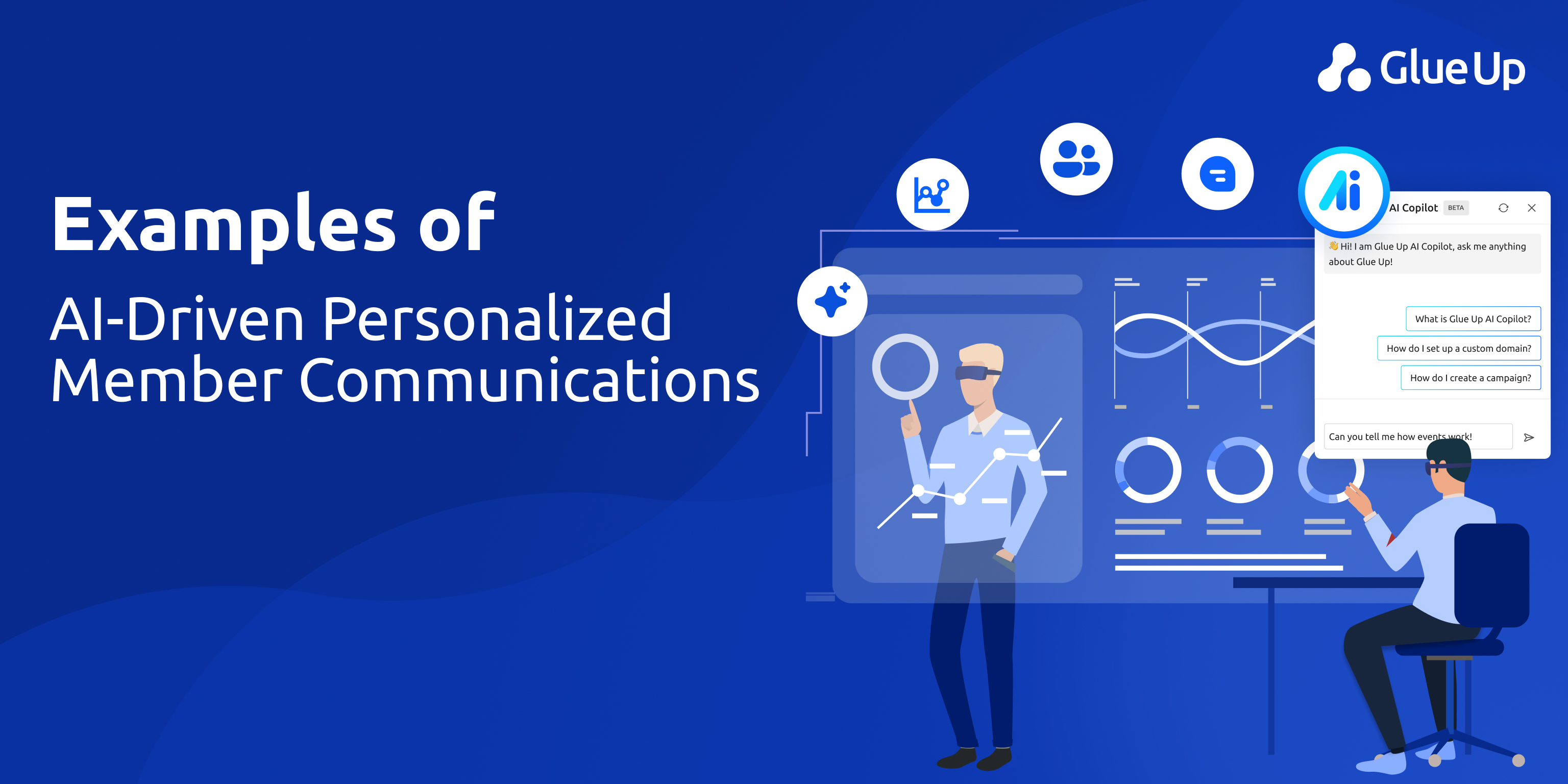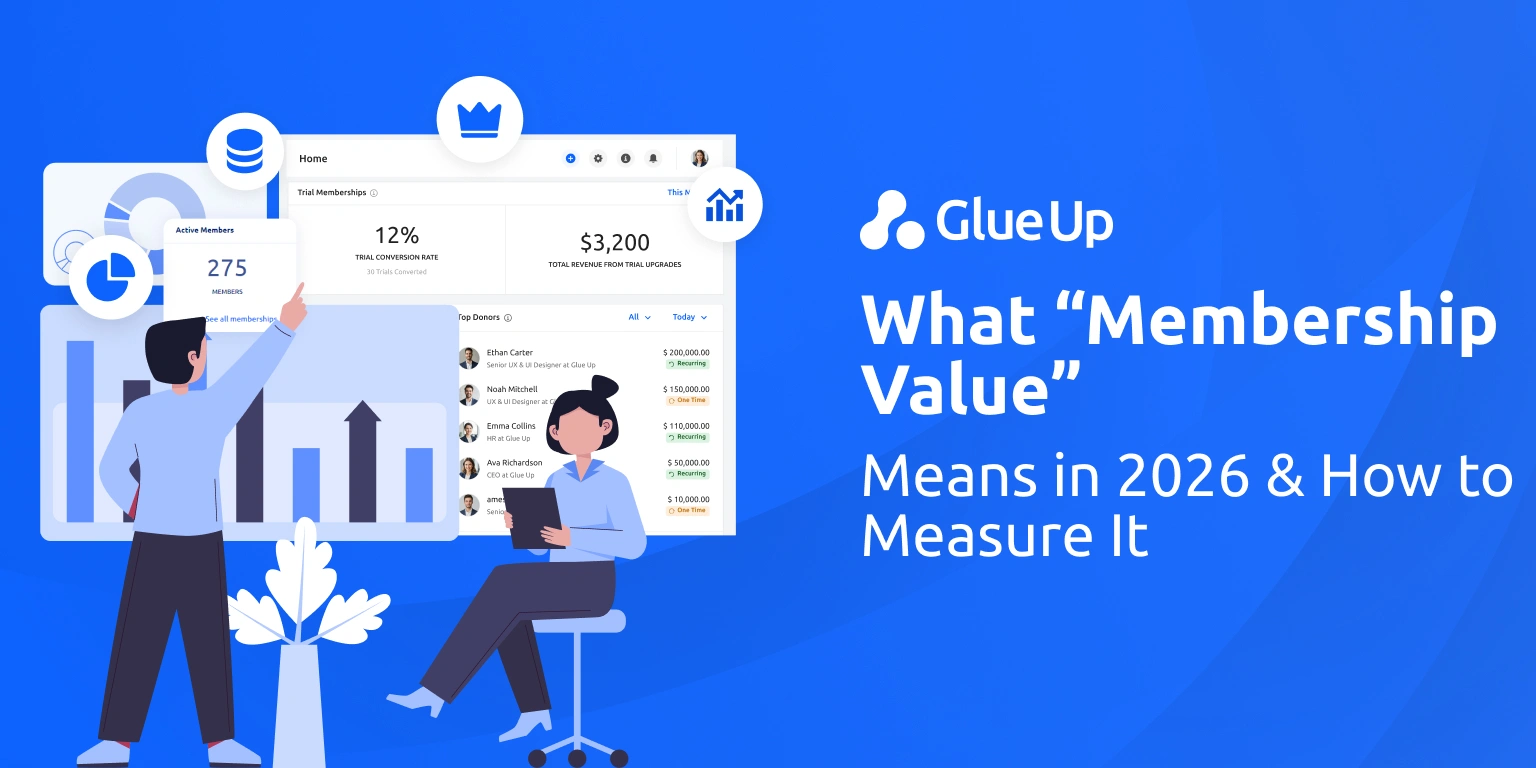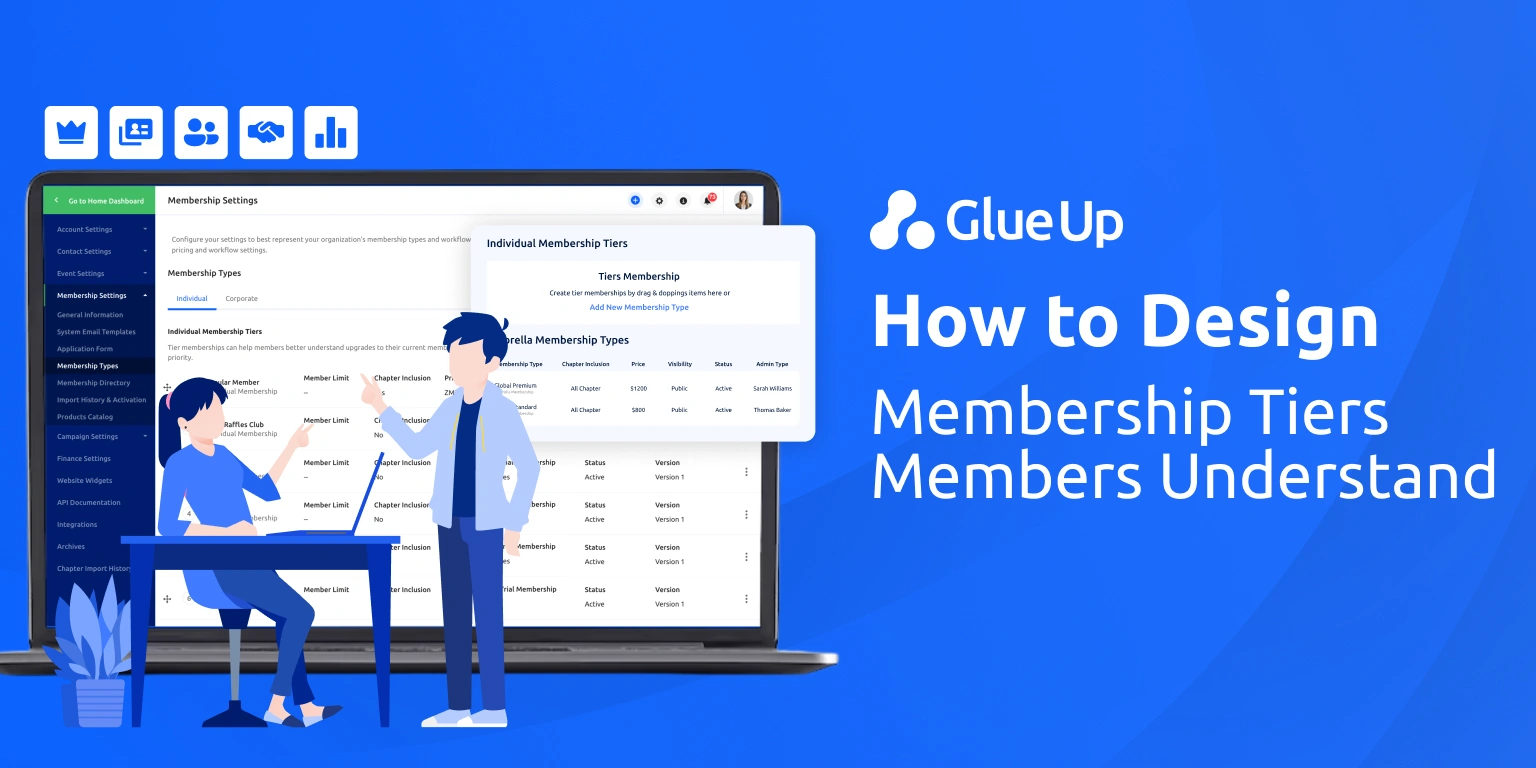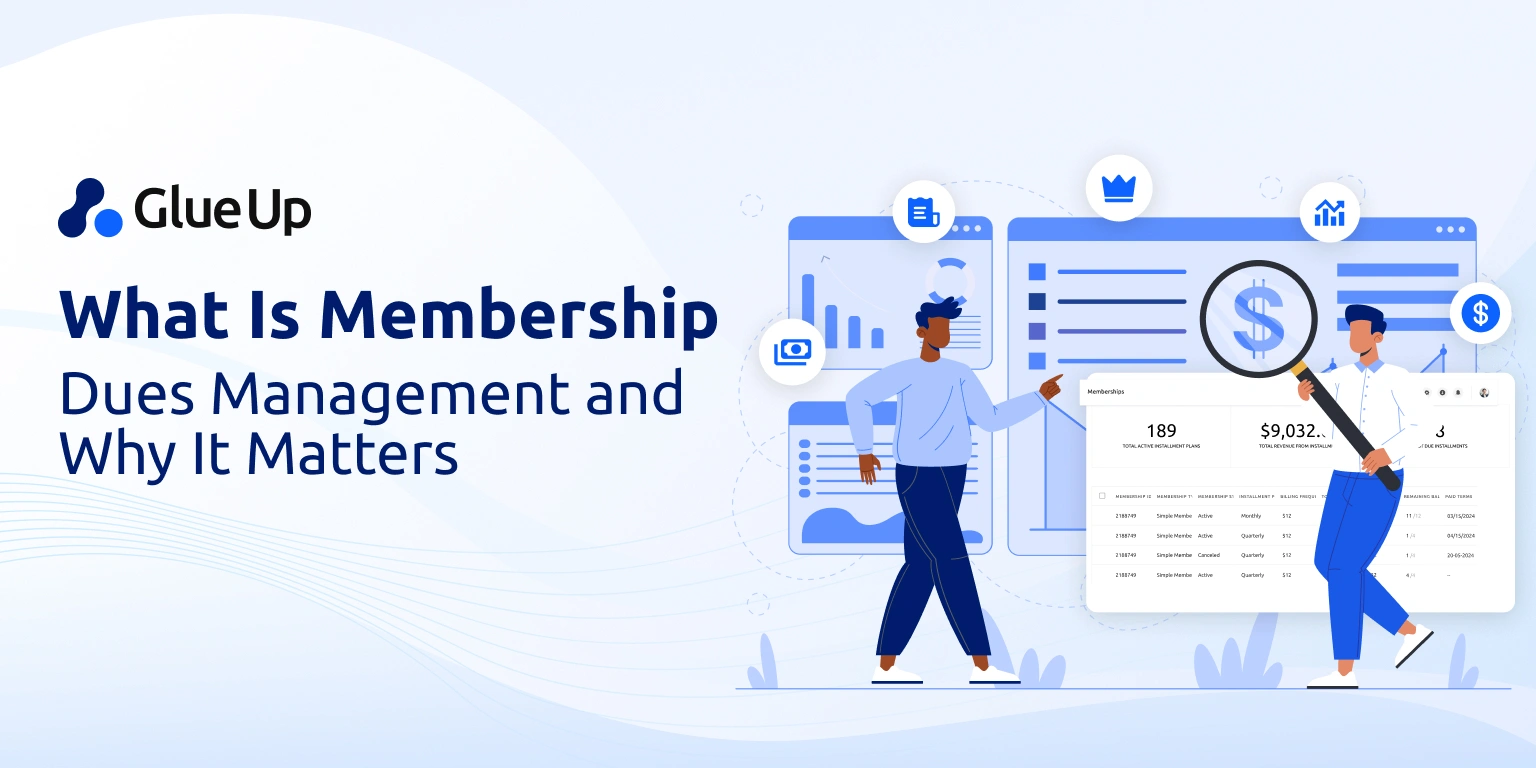
When your organization embraces AI-Driven Member Communications, you’re speaking to individuals: new members, renewing members, event-curious members; and you’re doing it with an intelligence that blends data, behavior, preference and timing so every message feels relevant, human, and timely.
In this piece we’ll walk through how member-based organizations can use AI-Driven Member Communications to boost engagement and retention, show sample welcome sequences, explore the data points you need, highlight tools and integrations, offer metrics to watch, and lay out event-recommendation examples. It’s part strategy, part tactical, all in plainspoken terms for associations who want to move past “spray and pray” outreach.
Key Takeaways
Personalization is making every member feel like you understand them. By combining behavioral data, event participation, and community activity, AI-driven member communications replace mass emails with messages that feel human and relevant.
Accuracy comes from data depth. The strongest signals are engagement patterns, event attendance, lifecycle milestones, and declared interests. When associations track these intelligently, AI can identify when and how to reach each member for maximum impact.
A fragmented tech stack limits insight. Platforms like Glue Up unify CRM, events, email, and community tools so AI can act on a single source of truth. With Smart Lists and the AI Copilot, associations can build, test, and refine campaigns directly from the same ecosystem.
Welcome sequences that adapt by interest, event invitations matched to geography, and digests curated by peer activity all deliver measurable lift. AI-driven member communications can reduce “time to first value,” increase event RSVPs, and push renewal rates above 90 %.
Success is visible in numbers: faster engagement, higher conversion, fewer manual touches, and stronger retention. Reporting on delivery, attention, interest, action, and renewal velocity transforms communication from a marketing expense into a strategic growth engine.
Quick Reads
What AI-Driven Member Communications Looks Like Now
Let’s start with the picture: a mid-sized professional association with 12 K members across industries, career-stages and geographies. Historically they sent one monthly email: association news, upcoming event, link to the member directory. Open rates hovered in the 30-35 % range, click-throughs were modest, renewal churn creeping up. Then they implemented an AI-Driven Member Communications approach.
Here’s what changed:
Their AI system flagged members who hadn’t logged into the member portal in 60 days, and delivered a tailored “we miss you” email with links based on their prior interests.
New members got a sequence of messages within their first 14 days, each personalized in tone and content using data (career stage, chapter, interest chip) and AI-selected content blocks.
Event invitations were no longer “all members invited” but “based on your past attendance, your region, your topic interest – we think you’ll like this session next week”.
Community digests were individualized: members who interacted with discussion threads about “governance” got recommended content on that, while those focused on “professional development” saw entirely different links.
The result is emailing engagement tripled, event attendance rose, and members reported greater perceived value. This is not science fiction; it reflects what organizations are now achieving when they apply AI to communication with intention.
If you’re wondering why this matters, the answer is simple: members expect relevancy. A recent industry blog says that associations must go beyond traditional one-size-fits-all outreach and instead “move to tailored interactions at every touchpoint.”
So, the question for your team becomes: how can we architect an AI-Driven Member Communications model that doesn’t feel experimental, but operational?
Data Your Model Needs for AI-Driven Member Communications
You can’t personalize what you don’t measure. The backbone of any AI-Driven Member Communications strategy is smart data. Below are the key categories of signals you’ll want, ordered roughly by strength of contribution.
Engagement behaviors – Last open, last click, which articles were read/downloaded, portal login recency, community forum activity. These are high-signal for likely future action.
Event-interaction signals – Which events a member registered for, which they attended, no-shows, session ratings, geographical location. Great for recommending the next best event.
Membership lifecycle metrics – Join date, tenure, dues tier, upgrades, renewal window approaching, payment method reliability. These are critical for timing and tone.
Community graph data – Which topics the member follows, which peer-groups they belong to, which threads they comment on. Helps personalize content and invites.
Declared profile attributes – Job function, seniority, industry, certification, chapter location. These are starting seeds before behavior matures.
Channel and device patterns – Mobile vs desktop opens, preferred send times, favorite channels (email, app push, SMS).
Support or ticket tags – If a member raised a support ticket, or changed category, you know what they care about or what friction they faced.
In practice, you’ll feed these into an engine (or workflow) that segments members in near-real time and drives personalized communication. According to a recent article, the “next best experience engine” rests on three model types: propensity (likelihood to act), channel (which channel works best), and value (lifetime value or near-term revenue), anchored by data engineering and advanced analytics.
An important note: you don’t need perfection on day one. Many associations start with declared profile data + one engagement signal (e.g., event attendance) and layer up. The goal is to start segments, learn, measure, refine.
Tools that Make AI-Driven Member Communications Practical
Okay, so you’ve got the data strategy. What about the tech stack? For member-based organizations the right tools bring together CRM/AMS, email/messaging automation, event system, and a layer of AI or dynamic content. Here are practical options:
Glue Up: An all-in-one platform that brings together membership management, event management, email marketing, and community engagement in a single ecosystem. The platform includes Smart Lists, which automatically segment contacts based on behavior, status, or engagement data, allowing organizations to maintain dynamic and up-to-date audiences. Glue Up also features an AI Copilot, designed to assist users in drafting messages, generating content, and personalizing communication using contextual data from across the platform.
Higher Logic Thrive: Built for associations, offers marketing automation workflows, content personalization, dynamic segmentation tied to AMS and community.
HubSpot Marketing Hub (paired with your AMS/CRM): Allows personalization tokens, dynamic content blocks, and recently features generative AI enhancements.
Integration is key. Your AMS must expose member data to your automation engine. The AI layer (either built‐in or via add-on) must be able to draw on that data, decide on content or segment, and deliver via the right channel at the right moment. As one industry article puts it: “Rather than replacing human‐driven efforts, AI is augmenting professionals’ ability to make smarter decisions and create meaningful engagement at scale.”
Examples to Swipe: Welcome Flows that Convert
Here’s a ready-to-use sequence you can adapt for your association. These are built around the principle of AI-Driven Member Communications, using data plus behavioral trigger plus personalized content. Use your automation tool to build this.
Day 0 – Instant Welcome
Subject: “Welcome, {{first_name}} — your quick start is here”
Body:
“Hi {{first_name}}, thanks for joining {{organization_name}}. Here are 3 personalized next steps just for you.”
Choose three actions based on member data: Join your chapter, set your interests (survey chip), bookmark an article or certification that matches their job function.
CTA: “Complete your profile →” (which will feed interest data and channel data)
Goal: instant value, TTFA (time to first action) ≤ 24h.
Day 2 – Interest Confirmation + Content Snack
Subject: “Liked {{interest_1}}? Here are two things worth your time”
Body:
We saw you marked interest in “{interest_1}” (or if they didn't answer, you can show “popular topics for new members like you”).
Provide two dynamic content blocks (AI selects based on interest): e.g., “5-minute video: Emerging trends in {interest_1}” + “Quick guide: How to get certified in {interest_1}”.
Invite them to join the community thread/clique around that topic.
Goal: deepen engagement, gather interest tag, segment them further.
Day 5 – Event Nudge Based on Location + Calendar Gap
Subject: “A great event nearby in {city}, only 20 minutes away”
Body:
Use event data + geo data. AI picks an event that matches their topic interest and location.
Provide two options: “Register now” or “Prefer to stay virtual? Join this webinar”.
Goal: event RSVP ≥7% for new member cohort, show value early.
Day 9 – Community Handshake
Subject: “Say hello in our {community_name} network”
Body:
Introduce them to 2–3 fellow members who share their interest or region (AI picks based on community graph).
Provide a pre-filled icebreaker message (“Hi – I’m {first_name}, I’m interested in {interest_1}, would love to hear how you handle {challenge}”).
Goal: build peer connection, increase login frequency.
Day 14 – Soft Value Recap + Micro-Ask
Subject: “How’s it going, {first_name}?”
Body:
Show a personalized “value scorecard”: three things you’ve done so far (e.g., “You logged in”, “You clicked a guide on {interest_1}”, “You RSVPed to event”).
Ask a single-question survey: “What would you like most from us next?” with options (e.g., certification help, networking, advocacy updates).
Soft ask: “Want to set your 90-day goals with us?”
Goal: gather feedback, tag for next nurture journey, strengthen connection.
Why this sequence works: It’s timely, targeted, uses real-data, and is orchestrated. It’s far beyond sending “Welcome to our association” generic email. It is an example of AI-Driven Member Communications in action.
Measuring AI-Driven Member Communications: The Board-Trusted Metrics
To get your board or leadership team on board, you’ll need results. Here are the key metrics to include and how to frame them in the context of AI-Driven Member Communications:
1. Delivery Health
Inbox placement rate, bounce rate, DKIM/DMARC alignment.
This shows your system is technically healthy.
2. Attention
Open rate trend (recognize many systems now shadow opens, so consider open rate as directional).
Unique opens in target segments.
Time-to-open distribution (how quickly after send do members open).
For associations, benchmark open rate of ~35-36% in 2024.
3. Interest
Click-through rate (CTR) per segment.
Click-to-open rate (CTOR).
Content-depth (how many tiles clicked, time spent).
Poll/survey response rate.
4. Action
Event RSVP rate.
Member portal login rate.
Renewal starts/completions.
Community posts created, replies made.
5. Velocity
Time to first value (TTFV) for new members, how quickly did they engage.
Days to renewal decision post-renewal notice.
6. Retention & Revenue
Renewal rate by segment (e.g., those who received personalized nurture vs those who didn’t).
Dues collected on time.
Lifetime value (LTV) improvements.
Variance in manual outreach touches (reduction in cost).
Frame a dashboard: “New member cohort (Jan–Mar): TTFV = 12 days, event RSVP = 24%, renewal-on-time = 91% vs previous cohort 82%.” That kind of concrete number makes AI-Driven Member Communications real.
AI-Driven Event Recommendations Members Actually Use
One of the most powerful applications of AI-Driven Member Communications is recommending the right event to the right member, at the right time. Below are use-case examples your association can adapt.
Collaborative filtering for events: Use the “members who attended X also attended Y” model. For example, if many of your governance-committee members also attend “Emerging Board Trends” you can recommend that to new governance-committee members. Good for associations with large event volumes.
Context-aware suggestions: Incorporate location, travel radius, availability, and even external factors (like weather). For instance: “Only 30 miles away – your topic interest event this Thursday evening” sends a clear signal of immediacy.
Cold-start fix: For new members you don’t have behavioral data yet. Use declared interest (from profile) + profile attributes (job function, seniority) to seed recommendations. After 1-2 events/in-community actions, shift to behavior data.
Popular-with-your-peers digests: Show trending events within member’s peer-group (same chapter, same industry, same job level) to create relevance by association. Industry commentary shows higher attendance when invitations emphasise peer activity.
Vendor case study (market reference): In a non-association context, McKinsey describes a telecom case where the “next best experience engine” delivered tailored messaging based on behavior and cut churn by 5 %. Adapt the logic to your membership events roadmap.
When deploying, consider the following steps:
Create a unified event attendance dataset (member id, event id, attendance yes/no, rating, location).
Build a recommendation engine (or use your event tool) that scores events for each member: topic match × geo-proximity × availability.
Feed recommendations into your communication system: “You might like” invite, with one-click register.
Monitor results: event sign-up rate, attendance rate, drop-off compared to generic invite.
Mistakes to Skip and How to Fix Them
Even the best strategy will hit roadblocks. When your goal is AI-Driven Member Communications, avoid these common pitfalls.
Token blanks and wrong names: If your email uses “Hi {{first_name}}” and your dataset has nulls, some members will see “Hi –“. That small mistake erodes trust. Always set defaults (“Hi there”). HubSpot and other systems emphasize token defaults.
Privacy and ethics concerns: AI personalization means you’re processing behavior. You must ensure consent, data minimization, transparency. One study on personalization found user agency concerns when systems lack transparency.
One‐off “AI blasts”: Many associations run one fancy personalized email, then revert to generic campaigns. For AI-Driven Member Communications to stick, you need a lifecycle embedded program, not a spray-and-pray burst.
Open-rate obsession: Especially with Apple’s Mail Privacy Protection and other privacy layers, opens are less reliable. Do not report to leadership only open-rates. Focus on clicks, actions, renewals.
Rigid segments, no learning: AI systems must learn. If you build segmentation and never revisit it, you’ll plateau. The McKinsey model emphasizes continuous analytics and learning loops.
Ignoring human touch: AI is not a substitute for human relationships. It augments them. One study in workplace communications shows employees feel greater motivation when they can override AI suggestions. This principle extends to member communication.
What Good Looks Like in 90 Days
Here’s a simple roadmap your team can follow to launch AI-Driven Member Communications and start delivering measurable results.
Weeks 1–2
Clean your contact database: ensure profile fields (first name, interest chips, chapter location) are populated and token defaults exist.
Build three Smart Lists/dynamic segments: (a) new members (joined ≤ 30 days), (b) at-risk renewals (<60 days to renewal), (c) event-curious (clicked at least 2 event emails in last 90 days but no registration).
Audit your tool stack: ensure your AMS/CRM, email tool, event platform and community tool can share data.
Weeks 3–4
Build and launch the five-step welcome flow (detailed above) using AI-driven blocks.
Add a 3-chip interest capture to every email.
Monitor week 1 results: open rate, click rate, profile update rate.
Set baseline for “time to first value” among new members.
Weeks 5–8
Turn on weekly personalised community digest: dynamically populated based on interest tags and behaviour.
Pilot next-best-event recommendations for one chapter or region. Send event-recommendation email to that segment only.
How are results? Track RSVP rate, attendance rate, drop-off compared to generic invite.
Weeks 9–12
Add two win-back automations (premade flows help) and a renewal countdown series.
Build board slide: “New-member cohort Jan–Mar: TTFV = 12 days vs prior 21 days; First-event attendance = 24% vs 15%; Renewal on-time = 91% vs 82%.”
Review and refine model: which interest tags were most predictive of action? Which channel worked best? Adjust segments accordingly.
Final thoughts
AI-Driven Member Communications is now a practical strategy for associations, chambers and non-profits that want to speak to their members like individuals. When you take the time to build the right data foundation, choose the right tools, design sequences that feel human, measure the right metrics, and evolve the model, you will move from “one-size” to “one-to-one”.
Members notice when you send something that is clearly for them, at the right moment, via the right channel. They talk about it. And when they feel seen, they stay longer, roll-up, participate more and become advocates. That kind of outcome is the promise of AI-Driven Member Communications, and one your organization can deliver.



